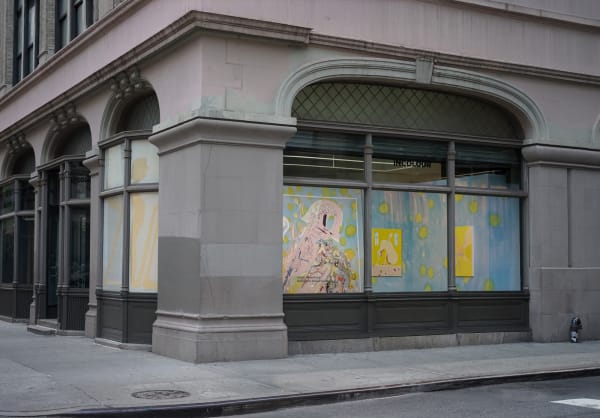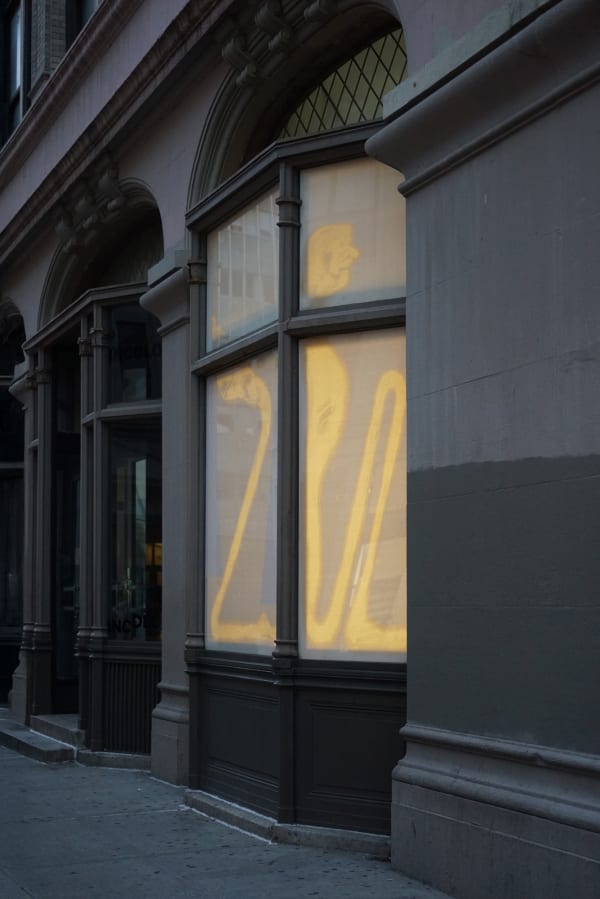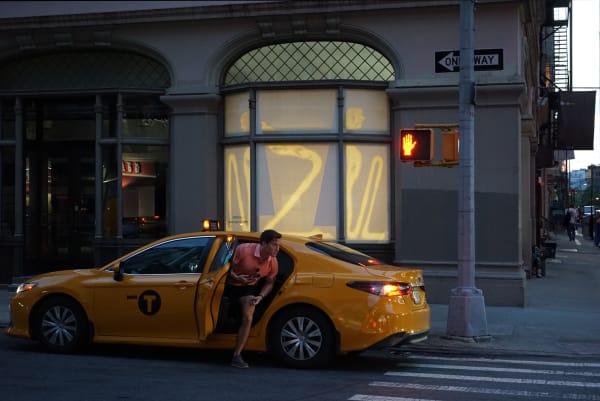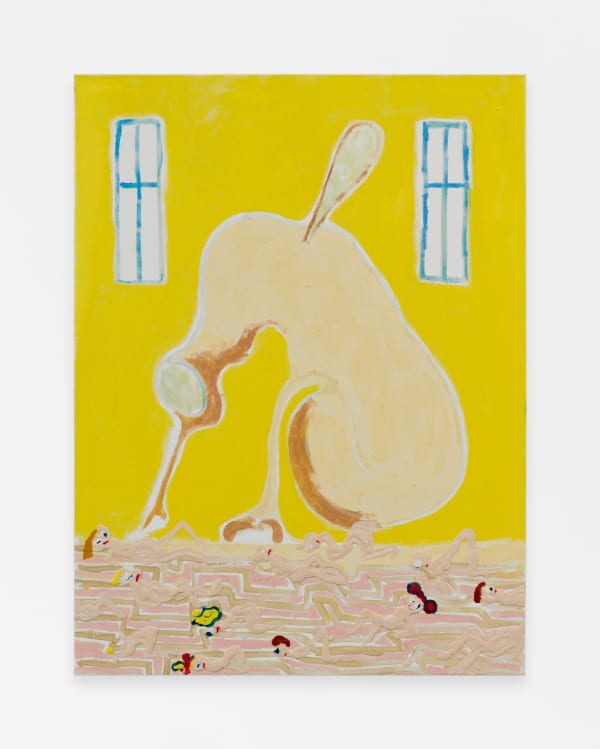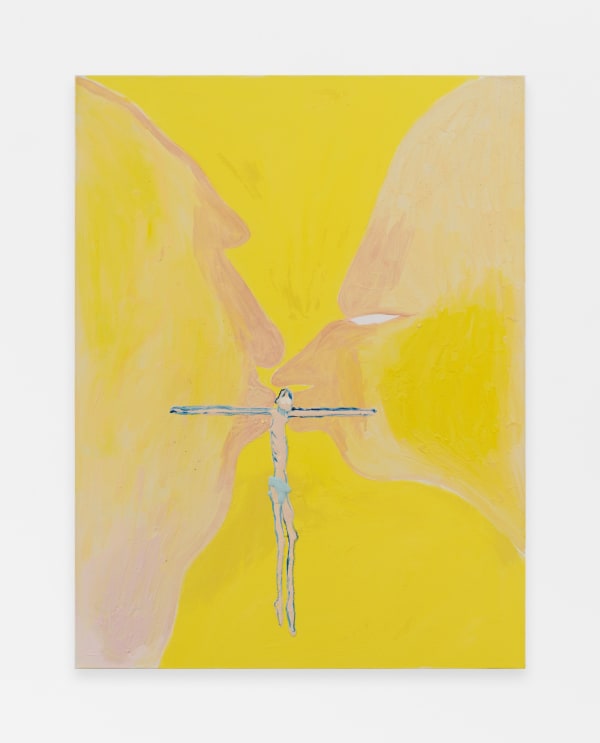Florian Meisenberg: Reading the Bible at the Beach
Opening Reception, Thursday, July 10 from 6-8pm
Anton Kern Gallery presents Reading the Bible at the Beach, New-York based, German-born artist Florian Meisenberg’s first exhibition at WINDOW. Meisenberg’s approach to the Anton Kern WINDOW space was a responsive one, beginning with a study of the site: two corner vitrines on the streets of Tribeca. The Lafayette window juts outward into the sidewalk, while the Walker window recedes inward and invites the viewer to peer in. Meisenberg saw in this physical contrast, convex versus concave, a conceptual hinge for the show. In the Walker vitrine, Meisenberg completely lines the walls with canvas, and on top of this hangs four new marble dust paintings and one large-scale self portrait. In the Lafayette vitrine, he embeds oil stain works, paintings made using only refined linseed oil as a medium—no pigments are used, which allows for the staining—directly into the window architecture.
For the exhibition, Meisenberg has wallpapered the Walker Street window with canvas. This canvas is tapestry-like, a chromatic field of otherworldly blues and yellows. In particular, the pattern for this backdrop derives from The smile of the beyond (2021), his monumental self-portrait, over 10 feet tall, which portrays the artist hunched in a radiant, almost apocalyptic world. In the painting, inner and outer realities merge: the artist appears to glow from within, with bodily matter exuding from his skin into luminous, permeable space. On the canvas backdrop hangs four figurative paintings in which the artist’s signature humanoids engage with ideas of birth, religion, death, and sex in an irreverent manner. For example, in the titular painting, two mostly feature-less men kiss each other and Jesus on a cross simultaneously while in Waste Treatment Plant a larger than life mosquito sucks the life out of many nude sunbathers. These four works are made with marble dust, a finely ground stone, applied while oil paint remains tacky on the canvas. This transforms the paint into something closer to a skin or shell and at times is even relief-like.
Over the past two years, Meisenberg has increasingly incorporated marble dust into his paintings, marking a subtle but significant shift in his practice. Working with the canvases flat on the studio floor (often with multiple in progress at a time), Meisenberg sifts the powder from above, allowing the dust to settle, adhere, and form unpredictable crusts or blooms. In some places, the dust binds thickly with the pigment, creating raised, almost topographical formations that echo the granular glint of sand. This process is repeated, with each painting developing its own sedimentary logic. Depending on the viewer’s position or the time of day, the works seem to shimmer, refract, and glow—engaging the viewer’s body not just visually, but spatially and sensorially.
Meisenberg has installed 6 panels forming one large oil-stain work within the space’s Lafayette window, which extends onto the street. Made with refined linseed oil on canvas—without any added pigment—the process focuses on staining, allowing the oil to bleed, merge, and spread across the surface. Meisenberg’s stains take the shape of human figures or silhouettes, captured in simple gestures or frozen in still poses, their ghostlike presence shifting with the changing light. At times, these figures appear to confront abstract yet obscurely linked forms, which are painted by the artist in white acrylic gesso. The gesso serves both as a visual boundary and a physical barrier which stops and contains the flow of oil during the staining process. This introduces a material tension between the organic, uncontrolled movement of the stain and the strict, imposed limits of the gesso.
The works in both vitrines resist control and embrace unpredictability. In the oil stain works, refined linseed oil slowly seeps into canvas, reacting to gravity, fiber, and time. The resulting forms are translucent and diffuse—less like images and more like atmospheric traces. By contrast, the marble dust paintings assert a tactile, sculptural presence. Together, these works suggest that painting is far more than just a flat image, but instead a living surface where materials, light, and meaning come together and interact.
-
 Florian MeisenbergIn my next life I want to live my life backwards. You start out dead and get that out of the way. Then you wake up in an old people's home feeling better every day. You get kicked out for being too healthy, go collect your pension, and then when you start, 2025
Florian MeisenbergIn my next life I want to live my life backwards. You start out dead and get that out of the way. Then you wake up in an old people's home feeling better every day. You get kicked out for being too healthy, go collect your pension, and then when you start, 2025 -
 Florian MeisenbergThe smile of the beyond, 2021
Florian MeisenbergThe smile of the beyond, 2021 -
 Florian MeisenbergWaste Treatment Plant, 2025
Florian MeisenbergWaste Treatment Plant, 2025 -
 Florian MeisenbergNo person is an island and No island is a person, 2025
Florian MeisenbergNo person is an island and No island is a person, 2025

